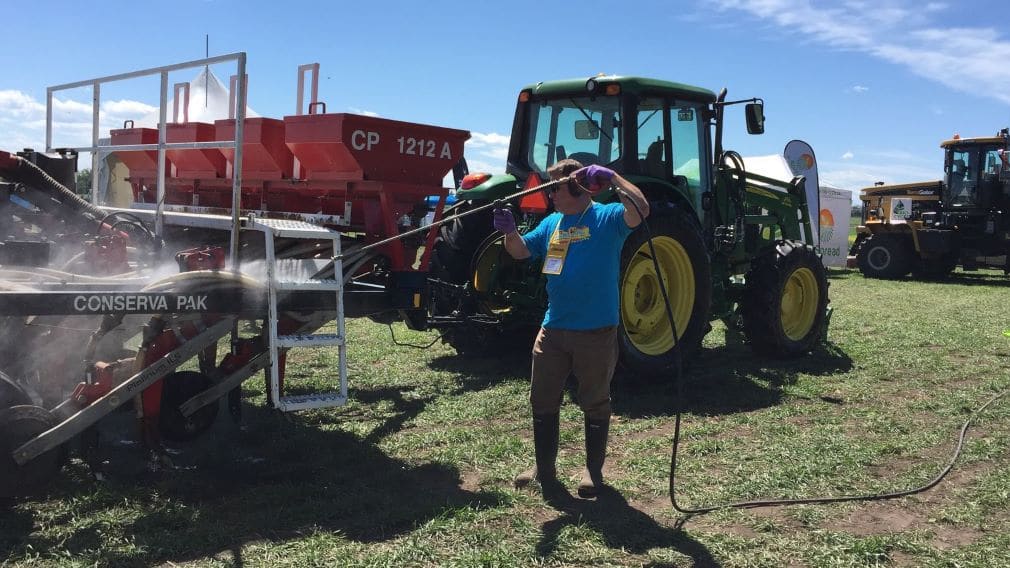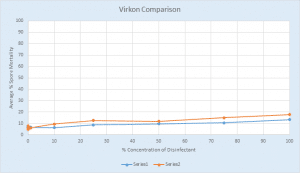
**Updated April 2020**
Sanitization to prevent the spread of clubroot starts with cleaning to remove soil and plant debris, and then disinfecting with a chemical that will kill the resting spores of the clubroot pathogen. Michael Harding with Alberta Agriculture & Forestry compared disinfectant solutions to see which is best to kill clubroot spores on machinery, tires, boots and hand tools. Content in this article is from Alberta Agriculture and Forestry’s “Preventing Clubroot: Agricultural Sanitation” factsheet, which summarizes Harding’s research.
The results
The most effective disinfectant was sodium hypochlorite (bleach). It was able to kill nearly 100% of the resting spores at bleach concentrations above 1.7%.
The second most effective disinfectant was Spray Nine, which killed almost 100% of the resting spores. Spray Nine comes as a ‘ready-to-use’ product and is used undiluted. The product contains ethoxylated C9-C11 alcohols and dipropylene glycol monobutyl ether as active ingredients.
The third most effective products were chlorinated degreasers called Adhere CPM and Premise Degreaser Plus which killed >95% of spores at product concentrations of approximately 10%. (The company says Premise is preferred over Adhere, “because it is safe on aluminum and will not damage equipment”.)
The fourth most effective product was AES 2500 which achieved 95% spore mortality at product concentrations above 50%.
Finally, ethanol and SaniDate (with actives hydrogen peroxide and peroxyacetic acid) could kill >95% of spores at concentrations of 75% and 90% respectively.
What about Virkon? Prior to this work, Virkon had been recommended as a disinfectant for clubroot sanitization protocols. However, the most recent disinfectant efficacy testing showed that Virkon was not effective at inactivating clubroot resting spores, even at the most concentrated solution that could be prepared (65 g/L). The figure below shows that Virkon could not kill more than 20% of the clubroot resting spores. Virkon is effective against commonly occurring viruses, bacteria and fungi, but is not effective against the thick-walled resting spores of the protist (Plasmodiophora brassicae) that causes clubroot. As a result of these test results, Virkon is not recommended for use when disinfecting surfaces for clubroot control.

Bleach is the best performer as well as inexpensive an easy to acquire. But Harding notes that, just like any tool, it also has its disadvantages. Bleach is corrosive to metals, causes rubber to harden, stains and damages clothing and footwear. He adds that the study did not evaluate corrosiveness or surface damage to metals, clothing or plastics for any products. Use caution and follow labels and SDS directions.
General tips for disinfecting footwear/tools
- Knock or scrape off any loose dirt from tools or footwear.
- Wash off any mud or clinging soil.
- Place in a container containing a disinfectant for 20 minutes or spray and keep soaked for 20 minutes. This 20-minute saturation is important for high efficacy. After 20 minutes, rinse with clean water to remove the disinfectant.
Tips for working with bleach
Check the product label for the concentration of sodium hypochlorite in the product. Use only sodium hypochlorite. Do not buy bleach unless the jug specifies sodium hypochlorite and includes the concentration. Dilute the product with tap water to obtain a 2% sodium hypochlorite solution.
Store all bleach solutions in a sealed container in a cool dark place to prevent inactivation by heat or light. When stored in a cool dark place, bleach will maintain its activity for up to one year. However, when stored at room temperature, bleach loses about 1% sodium hypochlorite every 100 days. In the cab or bed of truck, its activity would decay much more quickly.
- Bleach solutions stored at 4°C in the dark should be replaced at least once each year.
- Bleach solutions stored at room temperature should be replaced every 2 months.
- Bleach solutions stored in a vehicle or outdoors should be replaced weekly
- Bleach solutions that have come into contact with soil or organic matter should be replaced immediately.
- When in doubt regarding the activity of a bleach solution – prepare a fresh solution, or use a chlorine test strip to obtain an estimate of its effectiveness.
- Most microorganisms can be killed with a 0.5% bleach solution, so a 2% bleach is significantly more concentrated than normal “household bleach” products. Therefore 2% bleach is potentially harmful to the applicator. Contact with skin or inhalation of fumes should be avoided. Do not mix bleach with other chemicals. Always follow label and SDS recommendations for PPE and safe handling, storage and disposal.
Further reading:
- How clubroot spreads, which includes link to Equipment Sanitation Guide
- The Canola Encyclopedia has detailed information on clubroot prevention and management.
- Preventing Clubroot: Agricultural sanitation factsheet